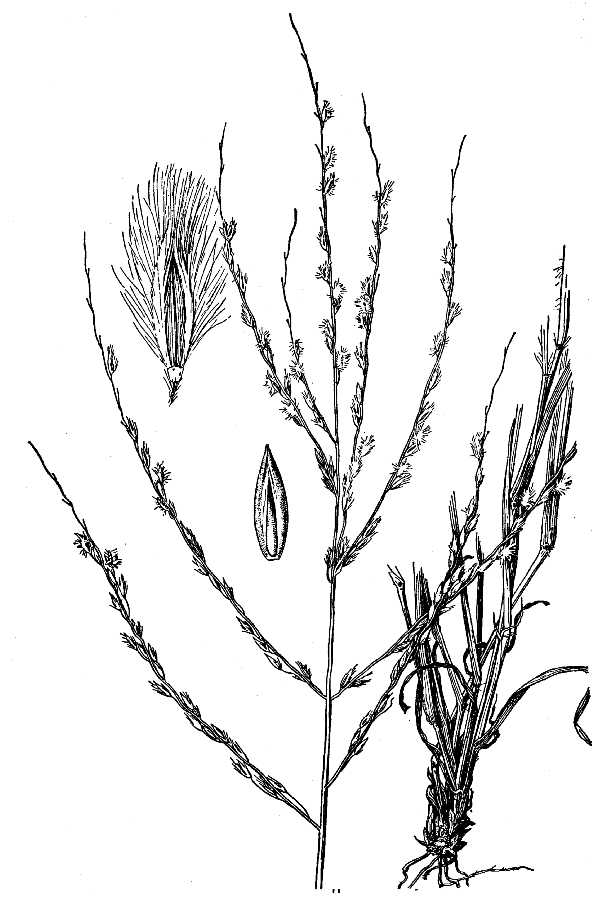Digitaria
|
Family: Poaceae |
Plants annual, perennial, or of indefinite duration. Culms 5-250 cm, erect or decumbent, branching basally or at aerial culm nodes, when annual or of indefinite duration usually decumbent and rooting at the lower nodes. Sheaths open; ligules membranous, sometimes ciliate; blades usually flat. Inflorescences terminal, sometimes also axillary, usually panicles of 1-sided spikelike branches (sometimes only 1 branch) attached digitately or racemosely to a rachis, sometimes simple panicles of solitary, pedicellate spikelets; spikelike branches, if present, sometimes with secondary branches, primary branch axes triquetrous, bearing spikelets abaxially, in 2 rows, usually in unequally pedicellate groups of 2-5, occasionally borne singly. Spikelets 1.2-8.2 mm, lanceoloid to ellipsoid, dorsally compressed, apices obtuse to acuminate, unawned, with 2 florets; disarticulation beneath the glumes. Lower glumes absent or to 1/4 as long as the spikelets; upper glumes usually from 1/6 as long as to equaling the spikelets, occasionally absent, 0-5-veined, usually pubescent; lower florets sterile; lower lemmas membranous, usually as long as the upper lemmas, usually pubescent, (3)5-7(13)-veined; lower paleas absent or reduced; upper lemmas mostly stiffly chartaceous to cartilaginous, obscurely veined, with 0.5-1 mm hyaline margins that embrace the upper paleas; upper paleas similar to the upper lemmas in texture and size; lodicules 3, cuneate; anthers 3. Caryopses plano-convex; embryos 1/5-1/2 as long as the caryopses; hila punctiform to ellipsoid. x = 9. Name from the Latin digitus, finger, a reference to the digitate inflorescence of some species. Spikelets with one perfect terminal fl, single or in clusters of 2 or 3 on unequal pedicels along one side of an elongate rachis, forming 2-several slender, spike-like racemes; first glume minute or lacking; second glume a third to fully as long as the spikelet, conspicuously 5- or 7-veined; sterile lemma (appearing as another glume when the first glume is obsolete) about as long as the fertile one; fertile lemma leathery with hyaline margins, acute, often shining, usually faintly marked with longitudinal rows of minute pits; palea flat, similar in texture to the fertile lemma, which clasps its margins; ours weedy annuals, branched from the base, with few-
several terminal, digitate or approximate, spike-like, one-sided racemes. (Syntherisma) 200+, cosmop. Gleason, Henry A. & Cronquist, Arthur J. 1991. Manual of vascular plants of northeastern United States and adjacent Canada. lxxv + 910 pp. ©The New York Botanical Garden. All rights reserved. Used by permission. |

